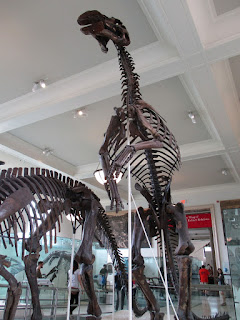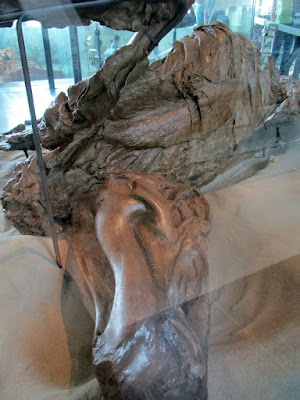And so, finally, to the hall of Ornithischian dinosaurs (as a reminder, Baron et al. 2017 isn't to be mentioned). In spite of the tendency of theropods and sauropods to hog the limelight, the AMNH's Other Dinosaur Hall almost manages to outshine the lizard-hipped-themed gallery - almost. There's no beating Rexy's charisma, but his eternal adversary certainly comes close.
Once upon a time, the AMNH's Triceratops stood immediately next to Rexy, the pair frozen on the cusp of a final showdown. While that must have been an inspiring sight, I'm quite glad that the three-horned one now sits among its relatives; it provides better evolutionary context, and besides, these animals are quite spectacular enough on their own. From the front, the lack of epoccipitals is striking, but then this frill has largely been reconstructed (so put your 'Toroceratops' hypotheses away for now). It's possible to walk all around the mount and take it in from every angle, which is a useful reminder of how wide the hips are.
To the left and in front of the Triceratops in the above photo is a very cool wall-mounted Centrosaurus, which sadly I didn't manage to get a good photo of - on a sunny day, the reflections can make taking decent photos of the glass-covered specimens very difficult. However, I did manage to get some decent shots of a fantastic nearby Styracosaurus. This historical specimen is quite heavily reconstructed in places, as I understand, but wonderful to see all the same. Once again, I must say what a treat it was to see all these specimens discovered by Barnum Brown, the stuff of Dinosaurs! magazine comic strip legend.
A nearby case of centrosaurine skulls proved difficult to photograph (more reflections), but I did have a little luck with a row of Protoceratops skulls. These really illustrate the huge amount of variation that can appear as the result of ontogeny within a single species. Furthermore, the preservation of tiny, delicate bones in some cases (such as in the second picture below) is really stunning. Note the bone projecting into the orbit.
In my first post, I mentioned how special it was to finally see the Velociraptor holotype skull. It was equally satisfying to finally see AMNH 1696, the near-complete Pachycephalosaurus skull (below) that appears in so many museums around the world in cast form. I'm not the sort of person to complain about casts being on show in museums - the original specimens need to be looked after and protected from The Public. However, I must admit that seeing the originals, the very fossilised remains of long-dead animals uncovered by the intrepid fossil hunters I read about as a child, is - dare I say it - magical. Like going to the Efteling on a quiet day.
Marginocephalians aside, the gallery is of course stuffed with superb hadrosaurs. The twin Trachedmontanatosaurotitans, while ostensibly quite modest when compared with Rexy or Bronto, are still world-famous and actually rather imposing in person. They're so often depicted as hapless tyrannosaur fodder that it's easy to forget that these were big animals, and I'm sure they were able to fend off many attackers with their sheer heft alone. The poses are dated now, but the idea of having one standing bipedally and one quadrupedally was ingenious.
Mounted nearby is the still-astonishing Barnum Brown Corythosaurus. Unfortunately, it's another one that's very difficult to photograph, but I appreciate the closeness to which one can get to this skeleton, even if it's behind glass. And yes, you can see the skin impressions, too.
And if you like a bit of dinosaur skin (steady now...) there's a cast of the "Trachodon" mummy nearby. Not the original, but then, it is a very precious specimen.
If one walks in from the Triceratops end, the thyreophorans sit behind the ceratopsians and opposite the hadrosaurs (andotherornithopods). The centrepiece among them is a mount of Stegosaurus, an impressive beastie with a droopy tail but a raised head. There's also a very few mounted bones from what appears to be a juvenile, with the rest of its frame filled out by a wire silhouette. It's a neat idea that is replicated elsewhere with a big wireframe Paraceratherium (with a mounted skull).
There's no full mount of an ankylosaur, but what's on offer is still pretty impressive. There are bits of Ankylosaurus, including its huge tail club, alongside a pavement of osteoderms from another animal (ashamedly, I can't remember which. Help!). The third photograph below features Euplocephalus' hips, which, needless to say, were very, very wide and flat, enough to remind me of my many boring train journeys in Holland. It's worth mentioning, again, the very unfussy presentation which serves to accentuate the specimens, while still providing plenty of information for those who are interested; these really are superbly designed displays, for the most part.
And finally...it's Edmontonia, it of the spiny shoulders and head like an angry battle sheep. I found this partial mount especially fascinating for some reason; I suppose its incompleteness lends it that extra air of authenticity. It may be of relatively modest proportions when compared with some of the other animals in the gallery, but suffice it to say that it looks like it could hold its own in a fight. Those spikes look mean.
I must say that it was a real pleasure to finally visit the AMNH, a museum I'd been dying to see for years, absolutely stuffed with amazing historical specimens including the most iconic Rexy of all (take a hike, Sue). There's a lot more besides dinosaurs, obviously - the breathtaking taxidermy displays, perhaps the best I've ever seen, are only the start. But that will have to wait for another day. For now I'd just like to thank our friend Nancy for showing Nicole and I around and for hosting us while we were in New York. As you can see, we had a wonderful time.























The armor is from Sauropelta. I believe
ReplyDeleteI think you're right, actually. Thanks, that was bothering me.
Delete